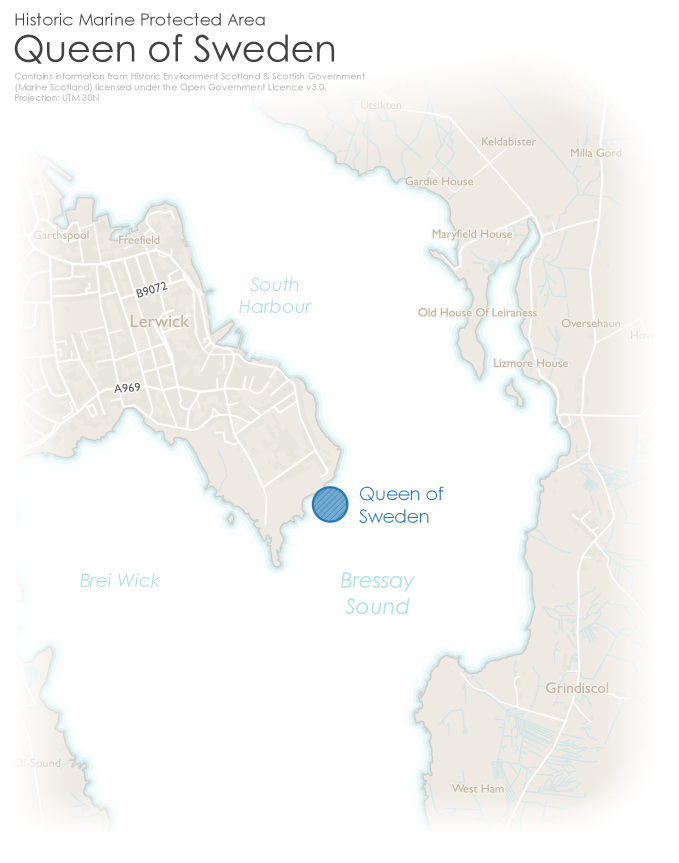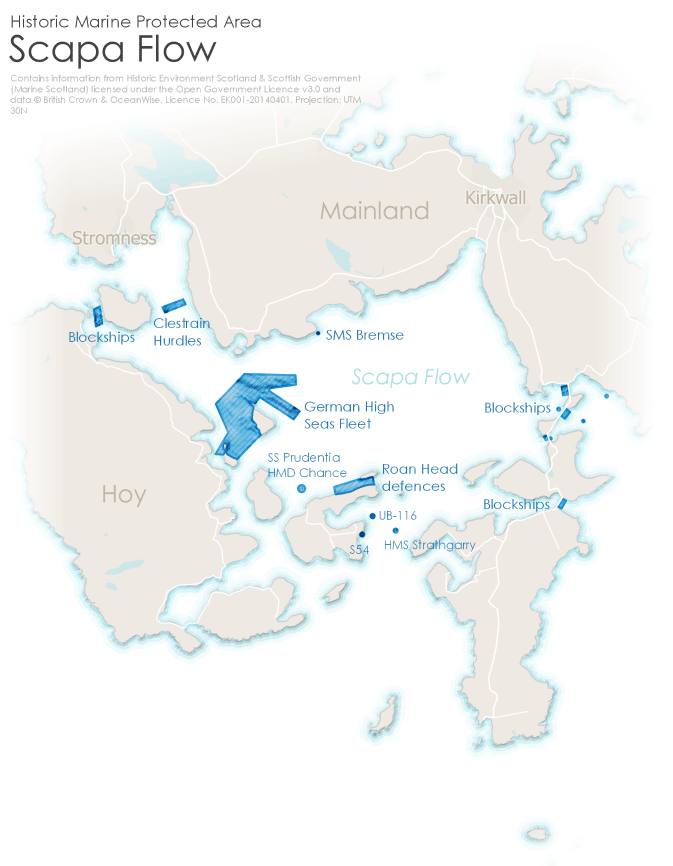Proposal to designate two historic marine protected areas: consultation
We would welcome your views on the potential creation of two historic marine protected areas, as part of the Scottish Marine Protected Area (MPA) network.
The proposals
Queen of Sweden, Shetland
The proposal concerns a wrecked vessel, believed to be the Drottningen af Swerige, or ‘Queen of Sweden’, a Swedish East Indiaman (an armed merchant sailing vessel of the Swedish East India Company) which hit a rock off the rocky headland of the Knab, while seeking shelter in Bressay Sound, Shetland on 12 January 1745. The remains lie at a depth of approximately 14-25m close to Twageos Point, at the southern entrance to Lerwick Harbour.
Historic Environment Scotland (HES) advise that the wreck of Queen of Sweden meets the criterion of national importance for designation as a Historic MPA. The wreck is arguably the best-preserved remains of a Swedish East Indiaman located in waters around Scotland. Although the wreck has been subject to historic salvage activity, key features are visible on the seabed and there is significant potential for further remains to be buried within the seabed sediments.
Combined with study of documentation in company archives, records of the ship’s loss and salvage, and an extensive collection of artefacts held by Shetland Museums, the remains of the wreck can significantly enhance our knowledge and understanding of vessels of the Swedish East India Company and its trading activity around Scotland’s coasts during the 18th century. Around this time, the Swedish East India Company played an important role in growing northern European trade with China in tea and silk.
The vessel’s loss in Bressay Sound bears testament to Shetland's strategically significant location on sea-routes linking northern Europe with the rest of the world. The loss of the Drottningen af Swerige was a significant event to local communities on Shetland at the time.
Designation as a Historic MPA would recognise the wreck’s national importance and promote responsible actions by sea-users. In particular, the site has been targeted recently by divers to recover lead ingots (carried as cargo), and it may continue to be vulnerable to unrecorded recovery of artefacts, without statutory protection. Designation will ensure that divers can continue to visit the site but on a look but don’t touch basis.
Figure 2: The Queen of Sweden site – the total area proposed for designation is 0.02 km2

Scapa Flow, Orkney
The proposal concerns places within Scapa Flow where the remains of historic shipwrecks and other structures of national importance are located that originate from Scapa Flow’s role as a Royal Navy base during the First (1914-18) and Second World Wars (1939-1945), as the anchorage where the German Imperial Navy’s High Seas Fleet was interned in 1918, and scuttled on 21 June 1919. Seven wrecks of the German High Seas Fleet, are currently recognised as nationally important scheduled monuments.
Historic Environment Scotland advise that many of the sites recorded through surveys undertaken since 2001 meet the criterion of national importance for designation as a Historic MPA. The range and quality of marine historic assets surviving on the seabed of Scapa Flow is outstanding and represents the largest relatively accessible concentration of warship wrecks and associated features in the UK, and possibly in European waters. These sites have a high potential to enhance our understanding about the key role Scapa Flow played as a naval base of outstanding strategic significance to the United Kingdom during both the First and Second World Wars of the 20th Century, and significant events in the wartime naval history of the North Atlantic that took place there.
The entire 20th-century naval history of Scapa Flow is illustrated at landscape scale through the survival of wrecks of naval ships, auxiliary vessels, a German submarine, the surviving remains of the German Imperial Navy’s High Seas Fleet interned at the end of the First World War, and remains of the marine defensive network. Taken together with information in archives, and museums, these sites have a high potential to enhance our understanding about 20th-century naval architecture, the operation of the naval harbour of Scapa Flow during wartime, German attempts to attack it, and the Admiralty’s ingenious and evolving strategies to defend Scapa Flow. This is perhaps most visible at the Churchill Barriers where the surviving blockships have become a fundamental part of the coastal landscape, a reminder of Orkney’s major contribution to the war effort.
The salvage sites of the German High Seas Fleet also have a high potential to help us understand the major programme of marine salvage that took place in Scapa Flow during the interwar years and continued after the Second World War. The marine historic assets within the area are directly connected with events which resonate with the public and are part of the national consciousness, such as the scuttling of the German High Seas Fleet. The loss of the sites within the area would significantly hinder our ability to understand these events and the key role played by Scapa Flow during two world wars.
The marine historic assets are located within an area that is an important economic marine resource and many of the wrecks are very popular for recreational diving. It is expected that designation will help to promote the heritage value of the sites, ensure that their national importance is considered in the management of change through planning and other regulatory processes, while fostering understanding and enjoyment amongst sea users.
Figure 3: The Scapa Flow proposal– the total area proposed for designation is 10.69 km2

Contact
Email: marine_conservation@gov.scot
There is a problem
Thanks for your feedback